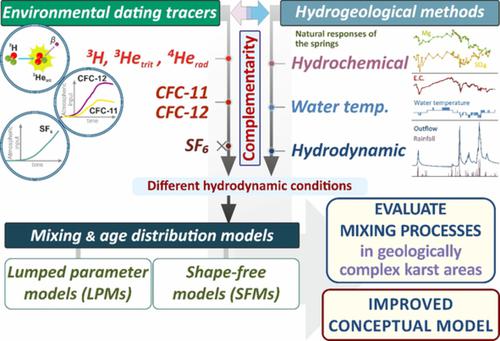当前位置:
X-MOL 学术
›
Hydrol. Process.
›
论文详情
Our official English website, www.x-mol.net, welcomes your
feedback! (Note: you will need to create a separate account there.)
Complementary use of dating and hydrochemical tools to assess mixing processes involving centenarian groundwater in a geologically complex alpine karst aquifer
Hydrological Processes ( IF 2.8 ) Pub Date : 2020-07-23 , DOI: 10.1002/hyp.13848 José Manuel Gil‐Márquez 1 , Beatriz De la Torre 1 , Matías Mudarra 1 , Jürgen Sültenfuß 2 , Bartolomé Andreo 1
Hydrological Processes ( IF 2.8 ) Pub Date : 2020-07-23 , DOI: 10.1002/hyp.13848 José Manuel Gil‐Márquez 1 , Beatriz De la Torre 1 , Matías Mudarra 1 , Jürgen Sültenfuß 2 , Bartolomé Andreo 1
Affiliation

|
Environmental dating tracers (3H, 3He, 4He, CFC‐12, CFC‐11, and SF6) and the natural spring response (hydrochemistry, water temperature, and hydrodynamics) were jointly used to assess mixing processes and to characterize groundwater flow in a relatively small carbonate aquifer with complex geology in southern Spain. Results evidence a marked karst behaviour of some temporary outlets, with sharp and rapid responses to precipitation events, while some perennial springs show buffer and delayed variations with respect to recharge periods. The general geochemical evolution shows a pattern, from higher to lower altitudes, in which mineralization and the Mg/Ca ratio rise, evidencing longer water–rock interaction. The large SF6 concentrations in groundwater suggest terrigenic production, whereas CFC‐11 values are affected by sorption or degradation. The groundwater age in the perennial springs—as deduced from CFC‐12 and 3H/3He—points to mean residence times of several decades, although the large amount of radiogenic 4He in samples indicate a contribution of old groundwater (free of 3H and CFC‐12). Lumped parameter models and shape‐free models were created based on 3H, tritiogenic 3He, CFC‐12, and radiogenic 4He data in order to interpret the age distribution of the samples. Results evidence the existence of two mixing components, with an old fraction ranging between 160 and 220 years in age. The correlation of physicochemical parameters with some dating parameters, derived from the mixing models, serves to explain the hydrogeochemical processes occurring within the system. Altogether, long residence times are shown to be possible in small alpine systems with a clearly karst behaviour if the geological setting features highly tectonized media including units with diverse hydrogeological characteristics. These findings highlight the importance of applying different approaches, including groundwater dating techniques, when studying such groundwater flow regimes.
中文翻译:

补充使用约会和水化学工具来评估地质复杂的高山喀斯特含水层中涉及百岁老人地下水的混合过程
环境测年示踪物(3 H,3 He,4 He,CFC-12,CFC-11和SF 6)和天然泉水响应(水化学,水温和流体动力学)共同用于评估混合过程和表征地下水在西班牙南部地质相对复杂的较小碳酸盐岩含水层中流动。结果表明,一些临时出口的喀斯特地貌特征明显,对降水事件反应迅速而敏锐,而一些多年生温泉则在补给期方面显示出缓冲和延迟的变化。地球化学的总体发展过程显示出从高海拔到低海拔的一种模式,其中矿化作用和Mg / Ca比值上升,表明水-岩相互作用更长。大型SF 6地下水中的浓度暗示着陆源产生,而CFC-11值则受吸附或降解影响。根据CFC-12和3 H / 3 He推算,多年生温泉的地下水年龄表明平均滞留时间为数十年,尽管样品中大量的放射源4 He表明了旧地下水的贡献(不含3 H和CFC-12)。集总参数模型和自由形状的模型中创建基于3 H,tritiogenic 3赫,CFC-12,和放射性4他提供数据以解释样品的年龄分布。结果表明存在两种混合组分,其旧组分的年龄介于160至220年之间。从混合模型得出的理化参数与某些测年参数的相关性,可以用来解释系统中发生的水文地球化学过程。总之,如果地质环境具有高度构造的介质,包括具有不同水文地质特征的单元,那么在具有明显喀斯特地貌的小型高山系统中,很可能会出现较长的停留时间。这些发现凸显了研究此类地下水流态时采用不同方法(包括地下水测年技术)的重要性。
更新日期:2020-07-23
中文翻译:

补充使用约会和水化学工具来评估地质复杂的高山喀斯特含水层中涉及百岁老人地下水的混合过程
环境测年示踪物(3 H,3 He,4 He,CFC-12,CFC-11和SF 6)和天然泉水响应(水化学,水温和流体动力学)共同用于评估混合过程和表征地下水在西班牙南部地质相对复杂的较小碳酸盐岩含水层中流动。结果表明,一些临时出口的喀斯特地貌特征明显,对降水事件反应迅速而敏锐,而一些多年生温泉则在补给期方面显示出缓冲和延迟的变化。地球化学的总体发展过程显示出从高海拔到低海拔的一种模式,其中矿化作用和Mg / Ca比值上升,表明水-岩相互作用更长。大型SF 6地下水中的浓度暗示着陆源产生,而CFC-11值则受吸附或降解影响。根据CFC-12和3 H / 3 He推算,多年生温泉的地下水年龄表明平均滞留时间为数十年,尽管样品中大量的放射源4 He表明了旧地下水的贡献(不含3 H和CFC-12)。集总参数模型和自由形状的模型中创建基于3 H,tritiogenic 3赫,CFC-12,和放射性4他提供数据以解释样品的年龄分布。结果表明存在两种混合组分,其旧组分的年龄介于160至220年之间。从混合模型得出的理化参数与某些测年参数的相关性,可以用来解释系统中发生的水文地球化学过程。总之,如果地质环境具有高度构造的介质,包括具有不同水文地质特征的单元,那么在具有明显喀斯特地貌的小型高山系统中,很可能会出现较长的停留时间。这些发现凸显了研究此类地下水流态时采用不同方法(包括地下水测年技术)的重要性。











































 京公网安备 11010802027423号
京公网安备 11010802027423号